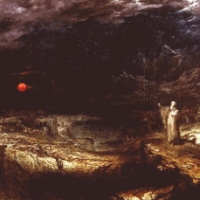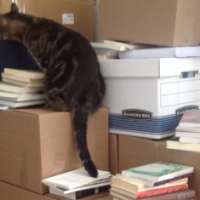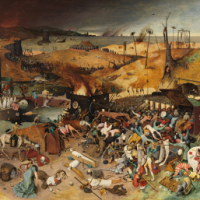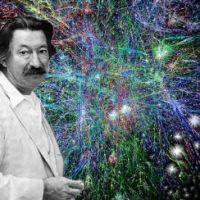The Apocalyptic Turn
It is a desperate deed
to upbraid despair
for despair makes our life what it is.
It thinks out
what we flee from.– Erich Fried
1)
Thinking about apocalyptic dangers is not a particularly uplifting activity.
At least not, that is, if one is trying to think of these risks in a serious way. True, all apocalyptic prognosticating consists of some degree of speculation, but that does not mean that all such thought tilts into the realms of speculative fiction. Dystopias, post-apocalyptic deathscapes, marauding zombie hordes, and astronauts on desperate missions to save humanity are easily digestible sorts of doom – they exist in a space that is separated enough from genuine threats as to allow them to retain a kernel of escapism. Such works are emotional pressure valves that allow people to momentarily acknowledge their cataclysmic fears while also reassuring them that when the last page is reached – or the credits roll – that everything will more or less be okay. Even if it ends horribly for the characters in the work of fiction, one returns to their own lived world of non-fiction and finds that it is still standing.
People show an impressive tolerance for doom-mongering, as long as such horrid scenarios remain safely fictional they can even be somewhat exciting. But when the threat of catastrophe starts to infringe too insistently upon reality it is most unwelcome. When the local movie theater’s screens are dominated by films in which the world is ending (or has ended) it’s not a cause for alarm – but when mainstream publications start saying the world is ending the siren is thoroughly unsettling.
2)
Published in New York Magazine, in the evening hours of July 9, 2017, David Wallace-Wells article “The Uninhabitable Earth” was a thoroughly unwelcome piece of writing. A self-consciously grim article, Wallace-Wells pulled away from the standard tactic of saying “it won’t actually be that bad” or of highlighting nifty high-tech solutions to instead suggest that climate change could actually be even worse than people commonly think. Without meaning to disrespect Wallace-Wells, there was little in his article that was wholly new. After all, there are plenty of books and articles floating around these days that warn in stark terms that at the rate we’re going much of the world is soon going to find itself floating around.
No, what set “The Unihabitable Earth” apart is that its place of publication was not a specialized academic journal, the missive of a radical green group, or a tract by a forgotten philosopher – but that it was published in a thoroughly mainstream popular periodical. New York Magazine is many things (some good, some bad) but it is hardly a radical (or environmental) magazine. It’s the type of magazine in which Frank Rich can humorously comment on the current state of the “National Circus,” in which Rebecca Traister can write of Hilary Clinton’s post-election life, in which Jonathan Chait can lambaste climate change pessimism by declaring that humans “finally got serious about saving themselves from themselves” (as he did in 2015), and in which Andrew Sullivan can continually lament about what Donald Trump has done to the Republican party. It can feature articles that speak of the presidency of Donald Trump in apocalyptic terms, but these pieces on the Trump presidency always retain a stolid certainty that life goes on. David Wallace-Wells broke one of the unspoken rules of such places, he wrote an article that looked out on the future of life going on, and asked “what if it won’t?” Again, there are no shortage of places to which one can turn for a steady dose of doom and pessimism, but magazines like New York are generally safe havens, if not committed counters, to such sentiments.
Thus the actual content of the article may ultimately be less interesting than the fact that the article exists and that it was published where it was published. What to make of this?
3)
Something has changed in recent years.
Let us call this “the apocalyptic turn.”
This is a “turn” that is visible in both public and academic discourse – and the “apocalyptic” to which it refers is that of climate change (which sometimes also gets discussed in somewhat altered form under the more academic moniker “the Anthropocence”). What the apocalyptic turn represents is the shift whereby the threat of climate change has moved from being some far off topic for scholarly debate to a matter where more and more people seem to be coming around to the sense that the catastrophe is coming. This does not mean that all the works that evince this turn share exactly the same conclusions about exactly what will happen or just how bad it will be, but they agree that changes are afoot, and they recognize that things are probably going to get worse.
It can be somewhat challenging to find an exact date for this turn, but a good candidate for it would be 2009. As Naomi Oreskes and Erik M. Conway put it in their book The Collapse of Western Civilization:
“The year 2009 is viewed as the ‘last best chance’ the Western world had to save itself, as leaders met in Copenhagen, Denmark, to try, for the fifteenth time since the UNFCCC was written, to agree on a binding, international law to prevent disruptive climate change.” (7)
The words “last best chance” in the above quotation, and the title of the book from which the quote comes, should be a clear signal that this conference did not produce the kind of “binding, international law” necessary. Thus, the apocalyptic turn is dated to the failure of Copenhagen – to the moment in which it became increasingly necessary to take the possibility of catastrophe seriously.
The works that can be seen as demonstrating the apocalyptic turn are numerous. Though, again, it should be noted that what unites such works is not an overt agreement, but a subtle leitmotif: the apocalypse needs to be taken seriously. Or, as Pope Francis put it in his Encyclical on Climate Change and Inequality (a work that is reflective of the apocalyptic turn):
“doomsday predictions can no longer be met with irony or disdain.” (98, paragraph 161)
In truth, if one wanted to sum up the apocalyptic turn in one punchy line, one could do far worse than the previous quip from Pope Francis.
The works and thinkers that bear the marks of the apocalyptic turn are too numerous to list. Nevertheless, some noteworthy cases include: Naomi Klein’s This Changes Everything, Bill McKibben’s Eaarth, McKenzie Wark’s Molecular Red, Rosalind Williams’ The Triumph of Human Empire, Donna Haraway’s Staying with the Trouble, and Isabelle Stengers’ In Catastrophic Times. And various gloomy journals from a variety of ideological perspectives – Dark Mountain, Salvage, Black Box – advance a similar line. There are many differences between these books and amongst their various authors – and some are much more hopeful about the possibilities that apocalyptic scenarios will open up, yet what unites them all is a certain level of agreement with Pope Francis’s comment that it’s time to take doomsday seriously. Originally published in French in 2009, Stengers book provides a clear case of the hopes that ran aground in Copenhagen and the grim turn that follows after; as she writes in the introduction to the 2015 edition of the book (English):
“Nor do we know how, in the best of cases, we might live in the ruins that it [climate change/the Anthropocene] will leave us: the window of opportunity in which, on paper, the measures to take were reasonably clear, is in the process of closing.” (10)
This “process of closing” is where works in the apocalyptic turn situate themselves. There is no longer time to prevent climate change, and thus the matter becomes one of seizing the moments still available in this “process” to plan and to prepare.
4)
Importantly, the apocalyptic turn is not synonymous with apocalyptic romanticism. Recognizing that the time has come to take apocalyptic dangers seriously in no way shape or form should be considered an eagerness to see those dangers unfold. Furthermore, it must be recognized and emphasized that for many people in the world today climate catastrophe is not some distant threat but something that is wreaking havoc on their lives in the here and now. That must be repeated, and so it shall be: for many people in the world today climate catastrophe is not some distant threat but something that is wreaking havoc on their lives in the here and now. It’s just, at risk of being crass, that those already bearing the brunt of climate change’s ills are probably not the readers or writers of New York Magazine.
A further challenge posed by the climate change catastrophe is that it is not easy to reduce it to a single one-off apocalyptic event. It is not a mushroom cloud hovering over a city, a giant monster rising from the depths of the sea, or a battle of biblical forces. Rather, climate change is a sort of rolling doom that gathers up all manner of other tragedies in its wake: droughts, famine, displacement, flooding, super storms. And from such calamities flow others such as wars, refugee crises, and races for resources in a ravaged world. There are lots of different “doomsday scenarios” bound up in climate change, as opposed to a single scenario. This can make it difficult to think through the danger of climate change. After all, in the 20th century those who were organizing against nuclear weapons had a specific threat they needed to stop: “the bomb.” Climate change makes it a lot murkier. With nuclear weapons the threat was that somebody would push “the” button, but with climate change the issue has to do more with the billions of button pushes that are bringing the catastrophe ever closer.
5)
Of course, most people do not like apocalyptic turns. And, in fairness, there is something about all apocalyptic premonitions that are, by definition, hyperbolic. Every forecast of catastrophe seems like an exaggeration until that event actually occurs – at which point it is too late. Claiming that Manhattan or Miami could be underwater seems ridiculous to many, and thus it such claims can be ridiculed, which does little to prevent this possibility. Or, to put it differently, it should not be surprising that “The Uninhabitable Earth” resulted in some swift and fierce responses.
The most important of these counters certainly came from Michael E. Mann – as he was interviewed by Wallace-Wells for the article – Mann disliked the “doomist” tenor of the argument and questioned many of the articles conclusions from a scientific standpoint. From a more overtly political perspective, Daniel Aldana Cohen took to the pages of Jacobin to denounce the article as “disaster porn” that ignores capitalism and the threat of eco-apartheid. While over at Grist, Eric Holthaus argued that scaring people about climate change just doesn’t work. All of these critiques of “The Uninhabitable Earth” have their fair points. Mann’s piece in particular is important as he takes Wallace-Wells to task for some of his hyperbolic claims and not quite accurate applications of the science. The Jacobin piece deserves special mention insofar as it performs a rather amusing bait-and-switch whereby it basically argues that the problem is just that Wallace-Wells was focused on the wrong apocalypse (the apocalypse is capitalism, not climate change). And the Grist piece repeats a fairly common argument from the less radical part of the environmental movement, namely that “scaring people doesn’t work.” It’s an argument that one fears frequently, though it seems that “we’ll figure it out,” “Elon Musk will save us,” “the next climate summit will actually work,” “just recycle more” arguments are far more prevalent than ones that wail “we’re doomed” – and, alas, those arguments haven’t worked either. Furthermore, it’s always a bit odd to see current environmentalists arguing that “doom mongering doesn’t work” when such tactics were a (successful) hallmark of the campaigns against nuclear weapons in the 20th century.
Nevertheless, all of the responses to “The Uninhabitable Earth” still fit within the terrain created after the apocalyptic turn. Sure the critiques of the piece may take great pains to distance themselves from actual apocalyptic or “doomist” discourse – but they still share the basic agreement that the threat is real, that it is very serious, and that something must be done. They may not agree about the scale of the danger (though that Jacobin piece is quite apocalyptic in its own ways), but they’re past the point at which people can act as though the danger isn’t there. They may even treat these “doomsday scenarios” with “irony” and “disdain” – and yet they can no longer just ignore them, or dismiss them to the fringe.
6)
So, what to do with about the apocalypse? There’s no easy answer to that.
Often the response is to rage fitfully against such a danger. To argue that there’s still time, to carefully present exactly what the findings really mean, to point to the steps that can (and must) be taken. If the occasional hyperbolic “doomist” piece can produce a deluge of such articles and commentary – is it really such a bad thing? Granted, this may be missing the point. For many of those who engaged in doom mongering in the 20th century the point of such bleak prophesizing was precisely to be hyperbolic – to scare people, to make them realize the worst case scenario. Such arguments were not about hard scientific facts (this degree means this), but about moral philosophy (you are responsible for the world) – and it is therefore understandable when matters get a bit mixed up. Because an ethical argument is one that does not line up evenly alongside scientific data. Or, to put it another way, the planet may still be inhabitable in 100 years (scientific argument), but regardless of that we need to take steps to help those being impacted by climate change right now (ethical argument). The two arguments do not actually cancel each other out, but if care is not taken the one can be used to scuttle the other: because the planet will still be inhabitable in 100 years we don’t need to worry about those currently suffering from climate change (this may be scientifically valid, but it is ethically abhorrent). One of the reasons why philosophers like Hans Jonas and Günther Anders took such strong positions on the importance of raising the “prophecy of doom” was because they recognized that those working in the hard sciences could not be bothered to really think through the full ethical implications of the science. Discussing an “uninhabitable world” is not really about science anymore, it’s about ethics. It comes down to thinking through what it means to live on a damaged world, and what it means to be responsible to one’s fellow humans – those are questions which are quickened by thinking in terms of “doomist” perspectives. And, frankly, if the catastrophe does not unfold as feared but out of that “doomist” concern steps had been taken to alleviate suffering in the world today – would that really have been such a bad thing? Ultimately, when confronted by apocalyptic threats, retreating to the science can work as an unfortunate way of avoiding facing the difficult ethical matters.
Thus, there is still an argument to be made for a productive pessimism. Though, it should be noted that the problem is not “optimism” or “pessimism” but apathy – which is a condition that can flow from either of those isms. And, once again, it must not be forgotten that all of the reprimands against “doomists” offer little comfort to the many people who are already struggling to survive under the conditions of climate change.
In thinking about the threat of approaching catastrophes, Walter Benjamin once observed:
“Before the spark reaches the dynamite, the lighted fuse must be cut.” (80)
But the situation we find ourselves in after the apocalyptic turn is the somber moment in which we have to acknowledge that the fuse won’t be cut in time, it’s already too late for that. However, this does not mean that all is lost – for there is time left on the fuse. One can still take steps to minimize the damage caused by the dynamite, to build structures that will withstand it, to warn people to seek shelter, to educate people on how the fuse came to be lit in the first place. And most importantly there’s still enough time left on the fuse to take steps to help those who have already been injured and who need assistance as they will bear the brunt of the harm if nothing is done. While scientists argue over just how bad the detonation will actually be there are important steps to be taken that are worth doing regardless of what happens when the fuse finally runs out.
But the first step that one has to take is to acknowledge that, regardless of its eventual size, the explosion is coming.
Works Cited
Benjamin, Walter. One Way Street. London: New Left Books, 1979.
Oreskes, Naomi and Conway, Erik M. The Collapse of Western Civilization: A View from the Future. New York: Columbia University Press, 2014.
Pope Francis. Encyclical on Climate Change & Inequality: On Care for Our Common Home. Brooklyn: Melville House, 2015.
Stengers, Isabelle. In Catastrophic Times: Resisting the Coming Barbarism. Paris: Open Humanities Press, 2015.
Related Content
Towards a Productive Pessimism
“I Study the End of the World”
The “Good Life” or the “Goods Life” – on Lewis Mumford
When Real Life Emulates Dystopia











Pingback: “Atomic warfare means universal extermination” | LibrarianShipwreck
Pingback: The Sorcerer’s Apprentice 2.0 | LibrarianShipwreck
Pingback: The Show that Cries Wolf – On Black Mirror’s Fourth Season | LibrarianShipwreck
Pingback: “Why don’t you go live in a cave?” – when technophiles cry troglodyte | LibrarianShipwreck
Pingback: The The Courage to be Afraid – a review of Roy Scranton’s “We’re Doomed. Now What?” | LibrarianShipwreck
Pingback: “The End of the World by Science” – an English translation of Eugene Huzar’s “La Fin du Monde par la Science.” Part 3 | LibrarianShipwreck
Pingback: A Disastrous Year – Reflections on 2018 | LibrarianShipwreck
Pingback: Between Salvation and Doom – Notes on the Green New Deal | LibrarianShipwreck
Pingback: “No one wants to see disaster coming, but those who look, do.” – A Review of “The Uninhabitable Earth” | LibrarianShipwreck
Pingback: “And here we are” – on HBO’s Chernobyl | LibrarianShipwreck
Pingback: Be Afraid! But not that afraid? – on Climate Doom | LibrarianShipwreck
Pingback: In Defense of Jonah | LibrarianShipwreck
Pingback: The End of the World? | LibrarianShipwreck
Pingback: What studying disasters has taught me about COVID-19 | LibrarianShipwreck
Pingback: Theses on Doomscrolling | LibrarianShipwreck
Pingback: The Cassandra Conundrum | LibrarianShipwreck
Pingback: “into the lifeboats” – a review of Nomadland | LibrarianShipwreck